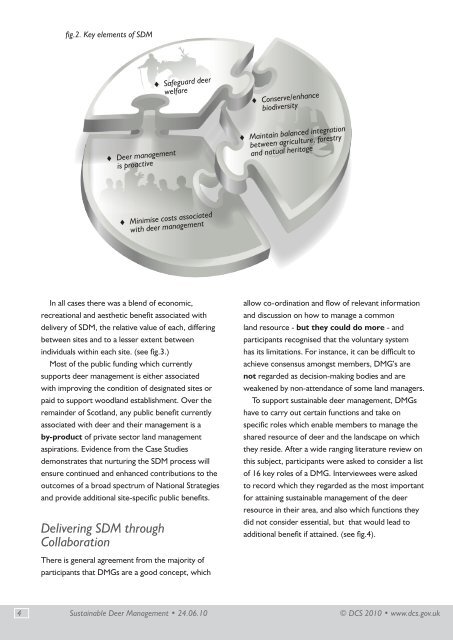Sustainable Deer Management A Case Study Report for the Deer ...
Sustainable Deer Management A Case Study Report for the Deer ...
Sustainable Deer Management A Case Study Report for the Deer ...
Create successful ePaper yourself
Turn your PDF publications into a flip-book with our unique Google optimized e-Paper software.
fig.2. Key elements of SDM<br />
♦♦<br />
<strong>Deer</strong> management<br />
is proactive<br />
♦ ♦ Safeguard deer<br />
welfare<br />
♦♦<br />
Conserve/enhance<br />
biodiversity<br />
♦♦<br />
Maintain balanced integration<br />
between agriculture, <strong>for</strong>estry<br />
and natual heritage<br />
♦♦<br />
Minimise costs associated<br />
with deer management<br />
In all cases <strong>the</strong>re was a blend of economic,<br />
recreational and aes<strong>the</strong>tic benefit associated with<br />
delivery of SDM, <strong>the</strong> relative value of each, differing<br />
between sites and to a lesser extent between<br />
individuals within each site. (see fig.3.)<br />
Most of <strong>the</strong> public funding which currently<br />
supports deer management is ei<strong>the</strong>r associated<br />
with improving <strong>the</strong> condition of designated sites or<br />
paid to support woodland establishment. Over <strong>the</strong><br />
remainder of Scotland, any public benefit currently<br />
associated with deer and <strong>the</strong>ir management is a<br />
by-product of private sector land management<br />
aspirations. Evidence from <strong>the</strong> <strong>Case</strong> Studies<br />
demonstrates that nurturing <strong>the</strong> SDM process will<br />
ensure continued and enhanced contributions to <strong>the</strong><br />
outcomes of a broad spectrum of National Strategies<br />
and provide additional site-specific public benefits.<br />
Delivering SDM through<br />
Collaboration<br />
There is general agreement from <strong>the</strong> majority of<br />
participants that DMGs are a good concept, which<br />
allow co-ordination and flow of relevant in<strong>for</strong>mation<br />
and discussion on how to manage a common<br />
land resource - but <strong>the</strong>y could do more - and<br />
participants recognised that <strong>the</strong> voluntary system<br />
has its limitations. For instance, it can be difficult to<br />
achieve consensus amongst members, DMG’s are<br />
not regarded as decision-making bodies and are<br />
weakened by non-attendance of some land managers.<br />
To support sustainable deer management, DMGs<br />
have to carry out certain functions and take on<br />
specific roles which enable members to manage <strong>the</strong><br />
shared resource of deer and <strong>the</strong> landscape on which<br />
<strong>the</strong>y reside. After a wide ranging literature review on<br />
this subject, participants were asked to consider a list<br />
of 16 key roles of a DMG. Interviewees were asked<br />
to record which <strong>the</strong>y regarded as <strong>the</strong> most important<br />
<strong>for</strong> attaining sustainable management of <strong>the</strong> deer<br />
resource in <strong>the</strong>ir area, and also which functions <strong>the</strong>y<br />
did not consider essential, but that would lead to<br />
additional benefit if attained. (see fig.4).<br />
4 <strong>Sustainable</strong> <strong>Deer</strong> <strong>Management</strong> • 24.06.10 © DCS 2010 • www.dcs.gov.uk
















